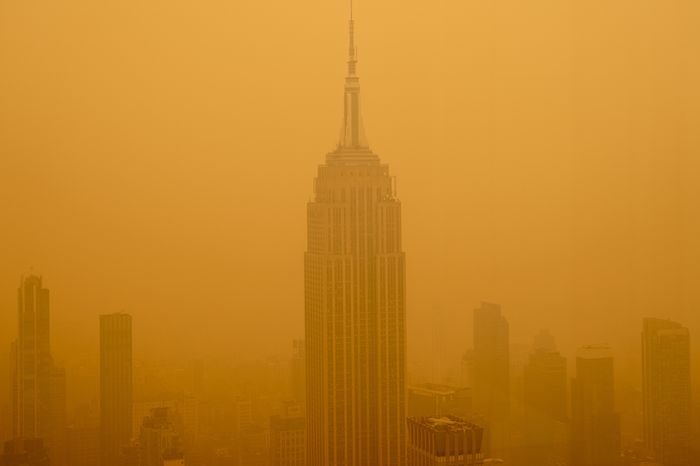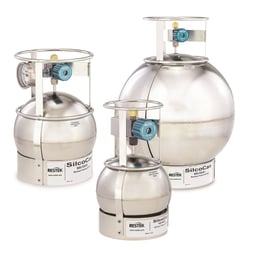
Smoke-filled haze from wildfires in Canada diminishes visibility in New York City on
June 7, 2023. Source: Getty Images.
SilcoNert-Coated Air Sampling Equipment Enables Accurate, Low-Level Analysis of Reactive Pollutants
The recent surge in wildfires across Canada has reached global discourse and raised concerns about air quality not only within the country but also in neighboring regions of the United States. The smoke and pollutants generated by these wildfires can have far-reaching consequences on human health and the environment. Monitoring air quality during such events is crucial for public safety and informed decision-making. In this blog article, we will explore the current impact of Canadian wildfires on air quality in Canada and the United States. We will also discuss the Air Quality Index (AQI), how air quality is measured, and the role of SilcoTek coatings in enhancing the accuracy of air quality monitoring systems.
Impact of the Canadian Wildfires on Air Quality
Wildfires release a variety of pollutants into the atmosphere, including particulate matter (PM), volatile organic compounds (VOCs), carbon monoxide (CO), and nitrogen dioxide (NO2). These pollutants can travel long distances, affecting air quality in both nearby and faraway regions. The recent Canadian wildfires have resulted in a significant degradation of air quality, not only in the immediate vicinity of the fires but also across large areas of Canada and even into the United States. The smoke plumes can lead to reduced visibility, respiratory issues, and exacerbation of pre-existing health conditions.
Understanding the Air Quality Index (AQI)
The Air Quality Index (AQI) is a standardized measurement tool used globally to assess and communicate air quality to the public. It provides a numerical value and corresponding descriptive category that indicates the level of pollution in a given area. The AQI typically focuses on pollutants such as PM2.5 (fine particulate matter with a diameter of 2.5 micrometers or less), PM10 (particulate matter with a diameter of 10 micrometers or less), ozone (O3), carbon monoxide (CO), sulfur dioxide (SO2), and nitrogen dioxide (NO2). The AQI values range from 0 to 500, with higher values indicating poorer air quality.
How Air Quality is Measured
Air quality is measured through the deployment of monitoring stations equipped with sensors and instruments that detect and quantify pollutants in the atmosphere. These stations collect real-time data on pollutant concentrations, meteorological conditions, and other relevant parameters. The collected information is then used to calculate the AQI and provide accurate and timely air quality updates to the public.
Air quality measurement starts with collecting a sample using an air sampling canister, such as Restek's SilcoCan which features our SilcoNert 2000 coating, also known by the trade name Siltek.
Here's an overview of how air sampling canisters are used in the measurement of air quality:
-
Sample Collection: Air sampling canisters are deployed at specific sampling locations to collect air samples over a predetermined period. The canisters are typically equipped with valves that allow controlled sampling, which should also be SilcoNert-coated for optimal results. During the sampling period, air is drawn into the canister, capturing the ambient air and any volatile compounds present in the environment.
-
Sample Preservation: Once the sampling period is complete, the valves on the canisters are closed to ensure the captured air sample is preserved without any alterations. The airtight seal provided by the canister as well as its inert coated metal surface helps maintain the integrity of the collected sample until it is ready for analysis.
-
Sample Transport: Air sampling canisters are designed to securely store the collected air samples, allowing for safe transportation to the laboratory for analysis. The robust construction of the canisters ensures that the samples remain undisturbed during transit, minimizing the risk of contamination or loss.
-
Laboratory Analysis: In the laboratory, the air sampling canisters are connected to analytical instruments, such as gas chromatographs (GC) or mass spectrometers (MS), for the analysis of target compounds present in the air sample. These instruments also include SilcoNert treated sample pathways to ensure maximum integrity. The captured air sample can be extracted from the canister using techniques like thermal desorption or headspace analysis, depending on the compounds of interest.
-
Compound Identification and Quantification: The analytical instruments connected to the air sampling canisters allow for the identification and quantification of specific compounds present in the air sample. By comparing the detected compounds to known standards and calibration curves, concentrations of various volatile organic compounds (VOCs) and other pollutants can be determined, providing insights into air quality and potential sources of pollution.
-
Data Interpretation and Reporting: The results obtained from the analysis of air samples collected in the canisters are interpreted and reported, typically in the form of concentration values for the target compounds. These results help assess air quality, identify pollutant sources, and provide valuable information for regulatory compliance, environmental impact assessments, and research studies.

Restek's SilcoCans with RAVE+ valves, featuring an inert internal surface that is coated by SilcoTek. Source: Restek Corporation.
The Role of SilcoTek Coatings in Accurate Air Quality Monitoring
SilcoTek coatings play a crucial role in enhancing the accuracy and reliability of air quality monitoring systems, particularly during events like Canadian wildfires. Here's how SilcoTek coatings contribute:
-
Inert Sampling and Analysis: SilcoTek coatings are applied to sample collection and measurement instrumentation surfaces, enhancing their sensitivity and selectivity. By reducing interference from other compounds and minimizing analyte adsorption and catalytic effects, these coatings ensure more accurate measurements of target pollutants. This is essential for distinguishing between actual pollution levels and background noise within samples, especially when dealing with low concentrations (sub-ppm) of pollutants.
-
Corrosion Resistance: Wildfire smoke contains corrosive gases that can degrade sampling components over time. SilcoTek coatings effectively shield metal surfaces from being exposed to the sample or application environment, preventing corrosion. This durability translates into reliable long-term measurements, reduces maintenance requirements, and saves money.
-
Sample Integrity: SilcoTek coatings are chemically inert and possess low surface energy, minimizing the loss of analytes during sample collection and transportation. This is particularly crucial when monitoring volatile compounds or trace gases, where even minor losses can lead to inaccurate measurements. SilcoTek coatings help maintain sample integrity, ensuring precise and representative air quality data.
SilcoTek coatings have been trusted by analysts to improve sampling of VOCs and have been cited in countless pieces of research. Learn more about how the Dutch Metrology Institute addresses VOC sampling challenges with SilcoNert:

The recent wildfires in Canada have had a significant impact on air quality in North America, necessitating accurate monitoring systems to safeguard public health. The Air Quality Index (AQI) serves as a vital tool in communicating air quality information to the public. SilcoTek coatings play a crucial role in improving the accuracy of air quality monitoring systems. By enhancing analyzer performance, corrosion resistance, and sample integrity, SilcoTek coatings contribute to more precise measurements of pollutants, enabling informed decision-making and effective mitigation strategies. As we continue to face the challenges of wildfires and other environmental impacts on air quality, technologies like SilcoTek coatings can play a crucial role in protecting human health and advancing science.



